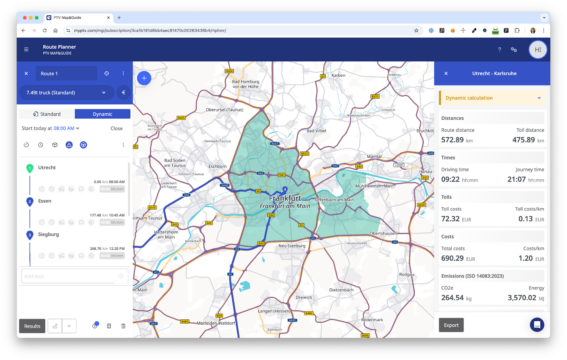Calculating Emissions in Transport & Logistics
CO2 Emission Allocation in PTV Map&Guide
As the logistics industry increasingly emphasizes sustainability, accurately calculating CO2 emissions has become a critical focus. With rising regulatory pressures and customer demands for transparency, companies must adopt standardized methods to track their carbon footprints. Utilizing frameworks such as the Global Logistics Emissions Council (GLEC) and ISO 14083 provides the necessary guidelines to ensure that emission calculations are both accurate and consistent. These standards help logistics providers assess their environmental impact, manage resources more efficiently, and align with global sustainability goals.
A Closer Look at the GLEC Framework and ISO 14083
Understanding the standards that guide emissions calculation is essential for logistics and transport companies. Two prominent frameworks are the ISO 14083 standard and the GLEC framework.
ISO 14083
ISO 14083 is an international standard that outlines the methodology for quantifying greenhouse gas emissions from logistics activities. It emphasizes the importance of a life-cycle perspective, meaning that emissions should be calculated from the moment goods leave the production site until they reach their destination. This includes considering all transport modes and the associated emissions, allowing companies to assess their environmental impact comprehensively. By adhering to ISO 14083, businesses can ensure their emissions reporting is credible and recognized globally.
GLEC
The Global Logistics Emissions Council (GLEC) framework complements ISO 14083 by providing a structured approach for companies to allocate emissions along their logistics networks. It promotes transparency and consistency in emissions reporting by recommending a method that considers the entire logistics process. The GLEC framework emphasizes the need for accurate data on fuel consumption, vehicle types, and operational practices, ensuring that all aspects contributing to emissions are accounted for. By following GLEC guidelines, companies can better manage their logistics emissions and work towards reductions over time.
CO2 Emission Calculation in PTV Map&Guide
PTV Map&Guide integrates the principles of ISO 14083 and the GLEC framework, offering users an intuitive platform for calculating CO2 emissions effectively. The software employs a robust allocation method that fairly distributes emissions produced during transportation across various stops. This approach not only enhances transparency but also enables companies to track their emissions consistently.
To get started, users can easily input or import their stops, including loading and unloading activities. Once the data is entered, PTV Map&Guide calculates emissions automatically, providing users with immediate insights into their carbon output. This streamlined process allows logistics managers to make informed decisions regarding route optimization and fuel usage, ultimately contributing to more sustainable operations.
CO2 Emission Reports in PDF
One of the standout features of PTV Map&Guide is its capability to generate detailed CO2 emission reports in PDF format. These reports provide a comprehensive overview of emissions data, making it easier for companies to share their sustainability efforts with stakeholders, clients, and regulatory bodies. The reports include:
- Summary of Emissions: A clear breakdown of CO2 emissions associated with specific routes, stops, and transport activities.
- Comparison Metrics: Insights into how emissions compare across different routes or time periods, helping businesses identify areas for improvement.
- Recommendations for Reduction: Actionable insights to enhance efficiency and reduce carbon footprints, aligned with best practices in the industry.
By utilizing the reporting functionality within PTV Map&Guide, companies can enhance their accountability and demonstrate their commitment to sustainable logistics practices.


